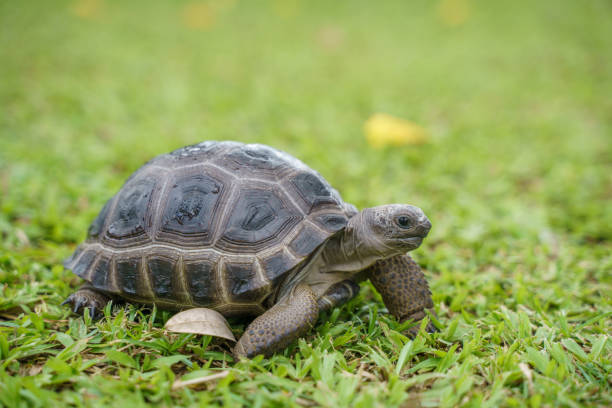
I’m still on an Aldabra-obsession phase. I mean I’ve been very interested with these tortoises but I think I’m reaching a fevered peak state these days.
So I know where to get an Aldabra now. I know where to get it nationally and I know where to get it locally.
For those dealers. You can find them in my previous article: Aldabra Tortoise Care
So, I’m at the phase where I’m fantasizing what to do if and when I finally get an Aldabra.
I’m thinking of getting it as a baby and what to do during the first 12 months. I know that even though they grow fast and eat like tiny bulldozers, these tortoises are small and delicate when they start out.
The key is to raise them up to the point that they become stable enough with age.
Month 0 – Arrival Day
This is probably the most crucial time and I will have to remind myself that I should leave the tortoise alone as much as possible. I will be tempted to pick it up from time to time but I should remind myself to leave it alone.
So future me: Leave the Tortoise Alone!
- Acclimate the tortoise in a warm, quiet area.
- Immediate check: bright eyes, strong head movement, no wheezing.
- First soak: 20–30 minutes in warm (not hot!) shallow water.
- Offer food right after the soak—Mazuri + greens.
- Keep the enclosure 80–90°F with a basking spot of 92–98°F.
- Zero handling except necessary checks.
Goal: Hydrate, settle, and observe.
Month 1 – Establishing the Routine
- Soak daily, 20 minutes.
- Feed every day: Mazuri, leafy greens (romaine, collards, dandelion), small amount of carrot or squash.
- Record weight every week—expect slow but steady gain.
- Keep substrate simple: grass, soil, sand mix, or indoor/outdoor carpet.
- UVB lights on 12–14 hours daily.
Goal: Hydration, heat stability, and consistent feeding.
Month 2 – Letting Them Explore
I know I’m not going to be able to help myself and by month 2 I’ll be raring to have more interaction with my Aldabra tortoise so I’ll have to keep reminding myself that this is not a cheap investment and I should be very careful because it is still going to be delicate.
- Still soaking daily, maybe skipping one day per week.
- Begin introducing grasses: chopped Bermuda, orchard grass, soft hay.
- Add environmental enrichment: rocks, low ramps, small hides.
- Continue daily feeding; observe stools (should be thick, fibrous).
- Check enclosure humidity—avoid overly wet conditions.
Goal: Introduce grazing behaviors, build leg strength.
Month 3 – Slightly Bigger Appetite, Slightly Bigger Space
- Increase greens portion; continue Mazuri but not every day—4× a week is good.
- You may offer cactus pads (opuntia), aloe, and hibiscus leaves/flowers.
- Soak every other day unless it’s looking dry or lethargic.
- Consider upgrading pen size; these small tortoises grow fast.
- Continue weekly weigh-ins.
Goal: Diet diversity + slow reduction of soaking frequency.
Month 4 – Settling Into a Groove
Based on Sam Pascucci’s Aldabra care sheet, their diet should now roughly be:
- 60% greens
- 20% grasses/hay
- 20% Mazuri/veggies
- Still soak 3× a week.
- Add more UV exposure time if outdoors is safe and warm.
- Let it walk on safe grassy areas supervised only—birds and dogs are threats.
Goal: Build muscle and digestion efficiency.
Month 5 – Health Checkpoint
- Growth should now be noticeable; shell should look smooth.
- If it’s growing <2.5 g/day average: increase greens/hay, check temps.
- Introduce small amounts of edible weeds (plantain, clover, purslane).
- Continue rotating foods weekly to avoid picky eating habits.
- Still avoid fruits except very rarely.
Goal: Confirm healthy growth and adjust diet as needed.
I still haven’t given up on the dream of becoming a veterinarian so maybe having an Aldabra is going to finally push me to becoming one. Why? And why at my age?
Why not?
Caring for animals require expert veterinary care. And that can easily rack up thousands of pesos per month especially if the zoo becomes a reality.
Month 6 – The Halftime Mark
- Soaking now 2× a week is typically enough.
- Start transitioning the diet heavily toward grasses and hay.
- Outdoor time if weather allows—always supervised.
- Add shaded mini-hut outdoors so it can choose microclimates.
- Shell brushing with soft brush once a week (just water).
Goal: Encourage natural grazing and independence.
Month 7 – Bigger Tortoise, Bigger Responsibilities
- Weight gain should be steady.
- Introduce more hay: timothy, orchard, Bermuda, soft alfalfa.
- Reduce Mazuri to 2–3× a week; keep calcium available.
- Consider making an outdoor pen (small but safe) if climate allows.
- Continue UVB indoors.
Goal: Strengthen gut flora and grazing instinct.
Month 8 – Personality Shows Up
- Tortoise should now be more active, exploratory, and food-motivated.
- Keep soaking 1–2× a week.
- Rotate food sources aggressively—Monotony = poor nutrition.
- Begin gentle desensitization: hand-feeding greens, slow approach from front.
Goal: Build trust and reduce stress around human caretakers.
Month 9 – Mini Bulldozer Mode
- Increase the enclosure’s complexity: low hills, uneven surfaces, logs.
- Adjust basking temp if needed; recheck equipment, replace bulbs.
- Weigh every 2 weeks.
- Start introducing edible shrubs if available: mulberry, hibiscus, bougainvillea (safe species only).
Goal: Encourage strength and natural browsing.
Month 10 – Pre-Adult Transition Starts
- Mazuri now 1–2× weekly.
- Greens + hay + fresh cut grasses dominate the diet.
- Outdoor time should be daily if temps are right.
- Soaking once a week or “as needed” based on hydration and stools.
Goal: Shift toward adult diet and behaviors.
Month 11 – Evaluate Housing for Year 2
At this point, the tortoise is probably getting too big for its starter setup. Because of that, I’ll have to plan for year two with this checklist:
- Upgrade to a larger indoor table or low pen.
- Start building or planning larger outdoor spaces.
- Ensure cooler months have a heated shelter lined up.
- Recheck predators: dogs, rodents, cats, birds.
Goal: Prepare for major growth in Year 2.
Month 12 – One Year Old
This is a milestone.
By 12 months, my Aldabra should:
- Be strong, active, and curious
- Have a smooth shell with no raised pyramiding
- Eat confidently and drink/soak normally
- Tolerate brief handling without panic
- Recognize me as “the food person”
Diet:
- Greens + hay as the backbone
- Mazuri only weekly
- Minimal fruit
- Unlimited grazing when outdoors
Soaking:
- Once a week or when weather is hot/dry.
Housing:
- Moving toward “juvenile phase”: bigger space, more grazing area, stable heat.
Goal: End the first year healthy, hydrated, and thriving—ready for the long journey ahead. Ok, that’s it for now!

